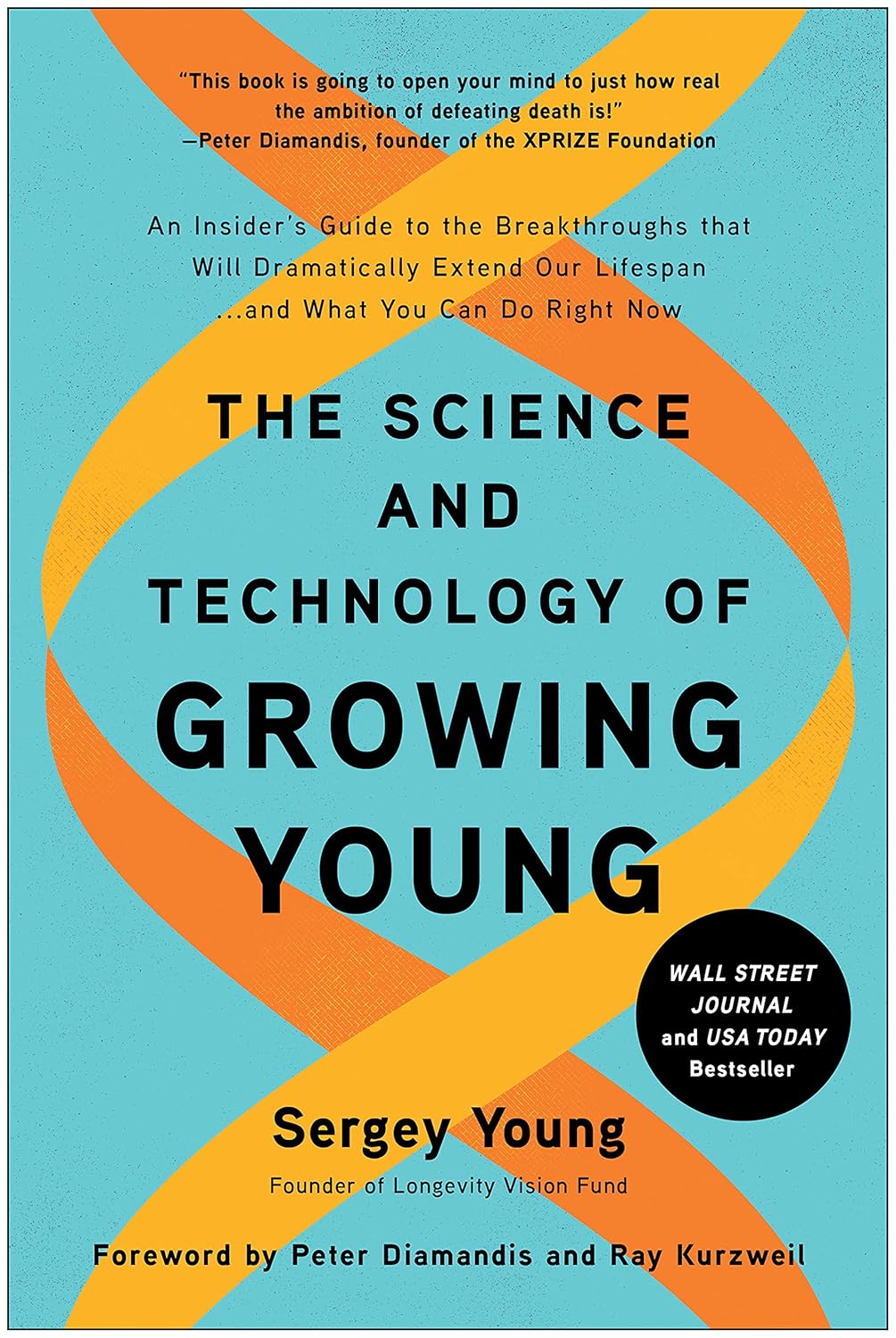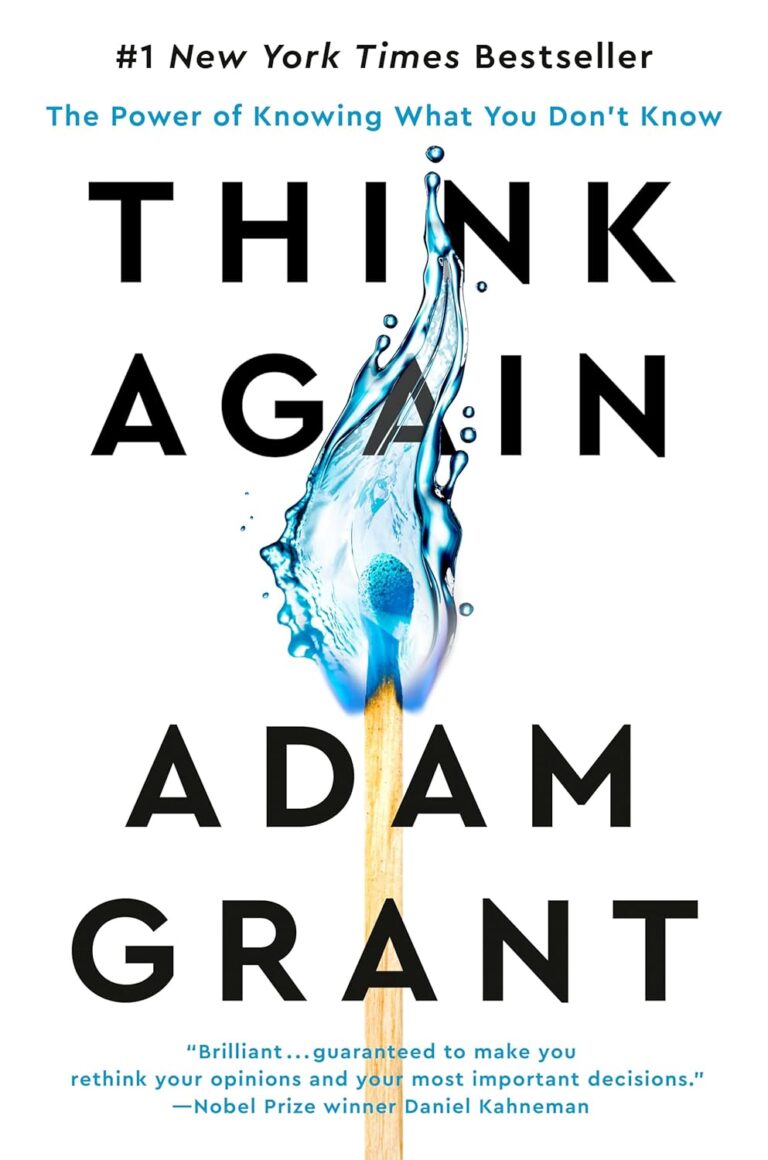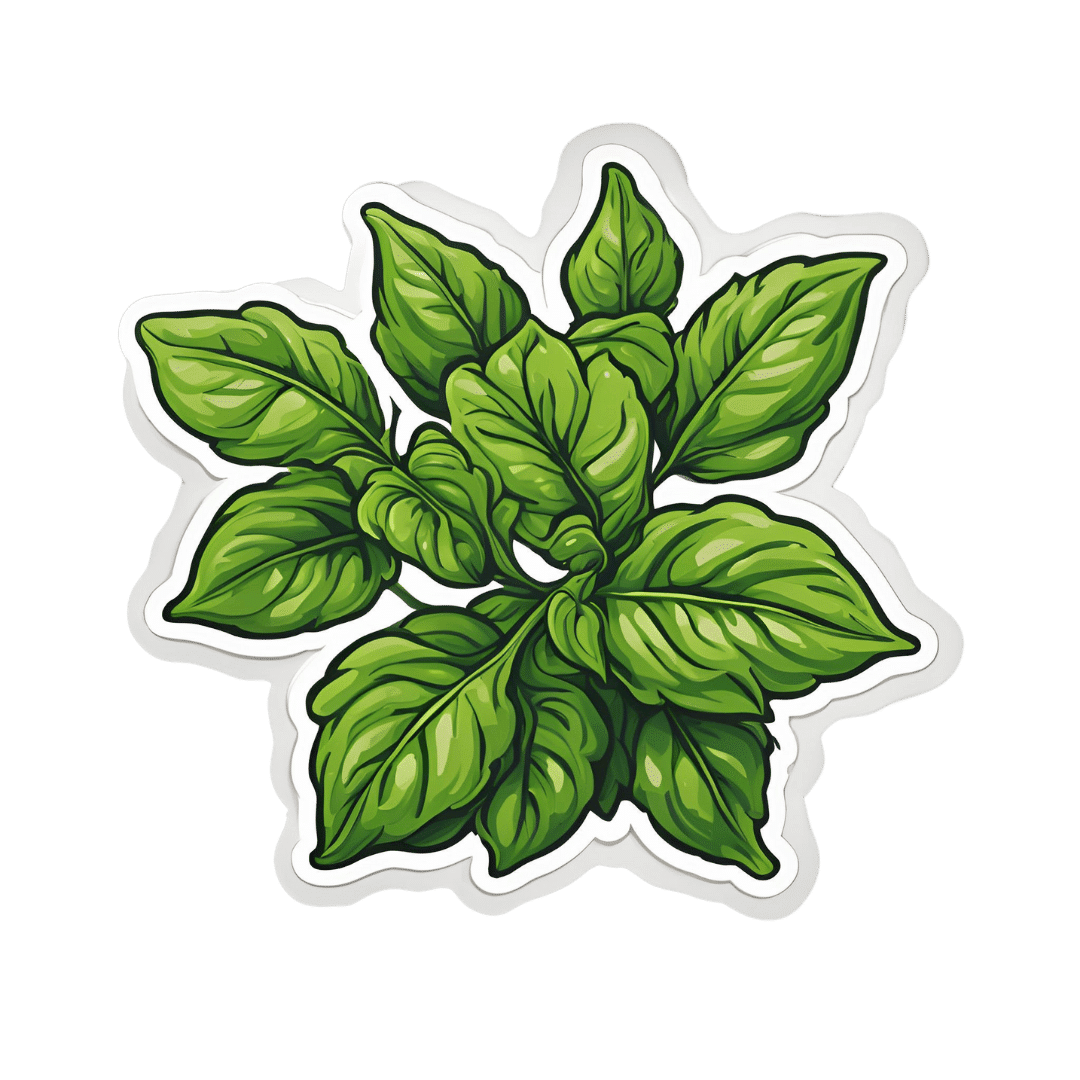
The Science and Technology of Growing Young – by Sergey Young
10almonds is reader-supported. We may, at no cost to you, receive a portion of sales if you purchase a product through a link in this article.
There are a lot of very optimistic works out there that promise the scientific breakthroughs that will occur very soon. Even amongst the hyperoptimistic transhumanism community, there is the joke of “where’s my flying car?” Sometimes prefaced with “Hey Ray, quick question…” as a nod to (or sometimes, direct address to) Ray Kurzweil, the Google computer scientist and futurist.
So, how does this one measure up?
Our author, Sergey Young, is not a scientist, but an investor with fingers in many pies. Specifically, pies relating to preventative medicine and longevity. Does that make him an unreliable narrator? Not necessarily, but it means we need to at least bear that context in mind.
But, also, he’s investing in those fields because he believes in them, and wants to benefit from them himself. In essense, he’s putting his money where his mouth is. But, enough about the author. What of the book?
It’s a whirlwind tour of the main areas of reseach and development, in the recent past, the present, and the near future. He talks about problems, and compelling solutions to problems.
If the book has a weak point, it’s that it doesn’t really talk about the problems to those solutions—that is, what can still go wrong. He’s excited about what we can do, and it’s somebody else’s job to worry about pitfalls along the way.
As to the “and what you can do now?” We’ll summarize:
- Mediterranean diet, mostly plant-based
- Get moderate exercise daily
- Get good sleep
- Don’t drink or smoke
- Get your personal health genomics data
- Get regular medical check-ups
- Look after your mental health too
Bottom line: this is a great primer on the various avenues of current anti-aging research and development, with discussion ranging from the the technological to the sociological. It has some health tips too, but the real meat of the work is the insight into the workings of the longevity industry.
Don’t Forget…
Did you arrive here from our newsletter? Don’t forget to return to the email to continue learning!
Recommended
Learn to Age Gracefully
Join the 98k+ American women taking control of their health & aging with our 100% free (and fun!) daily emails:
-
How Your Brain Chooses What To Remember
10almonds is reader-supported. We may, at no cost to you, receive a portion of sales if you purchase a product through a link in this article.
During the day, your brain is simply too busy to encode memories without interfering with normal processing. At night, however…
The filing system
The brain decides which memories to keep based on significance, using sharp brain wave ripples as an internal bookmarking system. Everyday memories fade, while important events are tagged in this manner for consolidation during sleep.
How does it do this? It starts in the hippocampus, which records experiences during wakefulness and replays them repeatedly at high speed during sleep, preparing them for transfer to the neocortex.
How do we know? Uniform Manifold Approximation & Projection (UMAP) for dimension reduction is a tool that condenses 400-dimensional neural activity data into 3D for visualization. Mice navigating a maze showed hippocampal activity encoding location and learning progression; it also showed neural patterns reflecting maze layout and task mastery.
What this means in practical terms: you need to get good sleep if you don’t want to lose your memories!
For more on all of this, enjoy:
Click Here If The Embedded Video Doesn’t Load Automatically!
Want to learn more?
You might also like to read:
How To Boost Your Memory Immediately (Without Supplements)
Take care!
Share This Post
-
Ideal Blood Pressure Numbers Explained
10almonds is reader-supported. We may, at no cost to you, receive a portion of sales if you purchase a product through a link in this article.
It’s Q&A Day at 10almonds!
Have a question or a request? You can always hit “reply” to any of our emails, or use the feedback widget at the bottom!
In cases where we’ve already covered something, we might link to what we wrote before, but will always be happy to revisit any of our topics again in the future too—there’s always more to say!
As ever: if the question/request can be answered briefly, we’ll do it here in our Q&A Thursday edition. If not, we’ll make a main feature of it shortly afterwards!
So, no question/request too big or small
❝Maybe I missed it but the study on blood pressure did it say what the 2 numbers should read ideally?❞
We linked it at the top of the article rather than including it inline, as we were short on space (and there was a chart rather than a “these two numbers” quick answer), but we have a little more space today, so:
Category Systolic (mm Hg) Diastolic (mm Hg) Normal < 120 AND < 80 Elevated 120 – 129 AND < 80 Stage 1 – High Blood Pressure 130 – 139 OR 80 – 89 Stage 2 – High Blood Pressure 140 or higher OR 90 or higher Hypertensive Crisis Above 180 AND/OR Above 120 To oversimplify for a “these two numbers” answer, under 120/80 is generally considered good, unless it is under 90/60, in which case that becomes hypotension.
Hypotension, the blood pressure being too low, means your organs may not get enough oxygen and if they don’t, they will start shutting down.
To give you an idea how serious this, this is the closed-circuit equivalent of the hypovolemic shock that occurs when someone is bleeding out onto the floor. Technically, bleeding to death also results in low blood pressure, of course, hence the similarity.
So: just a little under 120/80 is great.
Share This Post
-
How Useful Is Hydrotherapy?
10almonds is reader-supported. We may, at no cost to you, receive a portion of sales if you purchase a product through a link in this article.
Hyyyyyyydromatic…
Hydrotherapy is a very broad term, and refers to any (external) use of water as part of a physical therapy. Today we’re going to look at some of the top ways this can be beneficial—maybe you’ll know them all already, but maybe there’s something you hadn’t thought about or done decently; let’s find out!
Notwithstanding the vague nature of the umbrella term, some brave researchers have done a lot of work to bring us lots of information about what works and what doesn’t, so we’ll be using this to guide us today. For example:
Scientific Evidence-Based Effects of Hydrotherapy on Various Systems of the Body
Swimming (and similar)
An obvious one, this can for most people be a very good full-body exercise, that’s exactly as strenuous (or not) as you want/need it to be.
It can be cardio, it can be resistance, it can be endurance, it can be high-intensity interval training, it can be mobility work, it can be just support for an aching body that gets to enjoy being in the closest to zero-gravity we can get without being in freefall or in space.
See also: How To Do HIIT (Without Wrecking Your Body)
Depending on what’s available for you locally (pool with a shallow area, for example), it can also be a place to do some exercises normally performed on land, but with your weight being partially supported (and as a counterpoint, a little resistance added to movement), and no meaningful risk of falling.
Tip: check out your local facilities, to see if they offer water aerobics classes; because the water necessitates slow movement, this can look a lot like tai chi to watch, but it’s great for mobility and balance.
Water circuit therapy
This isn’t circuit training! Rather, it’s a mixture of thermo- and cryotherapy, that is to say, alternating warm and cold water immersion. This can also be interspersed with the use of a sauna, of course.
See also:
- Ice Baths: To Dip Or Not To Dip?
- Saunas: Health Benefits (& Caveats)
- The Stress Prescription (Against Aging!)
this last one is about thermal shock-mediated hormesis, which sounds drastic, but it’s what we’re doing here with the hot and cold, and it’s good for most people!
Pain relief
Most of the research for this has to do with childbirth pain rather than, for example, back pain, but the science is promising:
Post-exercise recovery
It can be tempting to sink into a hot bath, or at least enjoy a good hot shower, after strenuous exercise. But does it help recovery too? The answer is probably yes:
Effect of hot water immersion on acute physiological responses following resistance exercise
For more on that (and other means of improving post-exercise recovery), check out our previous main feature:
How To Speed Up Recovery After A Workout (According To Actual Science)
Take care!
Share This Post
Related Posts
-
Beating Toxic Positivity
10almonds is reader-supported. We may, at no cost to you, receive a portion of sales if you purchase a product through a link in this article.
How To Get Your Brain On A More Positive Track (Without Toxic Positivity)
There have been many studies done regards optimism and health, and they generally come to the same conclusion: optimism is simply good for the health.
Here’s an example we’ve mentioned before, but it’s a good introduction to today’s main feature. It’s a longitudinal study, and it followed 121,700 women (what a sample size!) for eight years. It controlled for all kinds of other lifestyle factors (especially smoking, drinking, diet, and exercise habits, as well as pre-existing medical conditions), so this wasn’t a case of “people who are healthy are more optimistic as results. And, in the researchers’ own words…
❝We found strong and statistically significant associations of increasing levels of optimism with decreasing risks of mortality, including mortality due each major cause of death, such as cancer, heart disease, stroke, respiratory disease, and infection. Importantly, findings were maintained after close control for potential confounding factors, including sociodemographic characteristics and depression❞
Read: Optimism and Cause-Specific Mortality: A Prospective Cohort Study
And yet, toxic positivity can cause as many problems as it tries to fix.
What is toxic positivity?
- Toxic positivity is the well-meaning friend who says “I’m sure it’ll be ok” when you know full well it definitely will not.
- Toxic positivity is the allegorical frog-in-a-pan saying that the temperature rises due to climate change are gradual, so they’re nothing to worry about
- Toxic positivity is thinking that “good vibes” will outperform chemotherapy
Sometimes, a dose of realism is needed. So, can we do that and maintain a positive attitude?
The answer is: somewhat, yes! But first, a quick check-in:
❝I’m not a pessimist; I’m a realist!❞
~ every pessimist ever
To believe self-reports, the world is divided between optimists and realists. But how does your outlook measure up, really?
While like most free online tests, this is offered “as-is” with the usual caveats about not being a clinical diagnostic tool, this one actually has a fair amount of scientific weight behind it:
❝Empirical testing has indicated the validity of the Optimism Pessimism Instrument as published in the scientific journal Current Psychology: Research and Reviews.
The IDRlabs Optimism/Pessimism Test (IDR-OPT) was developed by IDRlabs. The IDR-OPT is based on the Optimism/Pessimism Instrument (OPI) developed by Dr. William Dember, Dr. Stephanie Martin, Dr. Mary Hummer, Dr. Steven Howe, and Dr. Richard Melton, at the University of Cincinnati.❞
Take This Short (1–2 mins) Test
How did you score? And what could you do to improve on that score?
First, it’s said that with a big enough “why”, one can overcome any “how”. So…
An attitude of gratitude
We know, we know, it’s very Oprah Winfrey. But also, it works. Take the time, ideally daily, to quickly list 3–5 things for which you feel grateful. Great or small, it can be anything from your spouse to your cup of coffee, provided you feel fortunate to have it.
How this works: our brains easily get stuck in loops, so it can help to nudge them into a more positive loop.
What about when we are treated unfairly? Are we supposed to be grateful?
Sometimes, our less positive emotions are necessary, to protect us and/or those around us, and to provide a motivational force. We can still maintain a positive attitude by noting the bad thing and some good, but watch out! Notice the difference:
- “How dare they take our healthcare away, but at least I’m not sick right now” (lasting impression: no action required)
- “At least I’m not sick right now, but how dare they take our healthcare away!” (lasting impression: action required)
It’s a well-known idea in neurolinguistic programming, that “but” negates whatever goes before it (think of “I’m sorry but”, or “I’m not racist but”, etc), so use it consciously and wisely, or else simply use “and” instead.
Cognitive reframing: problem, or opportunity?
Most problems can be opportunities, even if the problems themselves genuinely suck and are not intrinsically positive. A way of leveraging this can be replacing “I have to…” with “I get to…”.
This not only can reframe problems as opportunities, but also calls back to the gratitude idea.
- Instead of “I have to get my mammogram / prostate exam” (not generally considered fun activities), “I get to have the peace of mind of being free from cancer / I get to have the forewarning that will keep me safe”.
- Instead of “I have to go to work”, “I get to go to work” (many wish they were in your shoes!)
- Instead of “I have to rest”, “I get to rest”
When things are truly not great
Whether due to internal or external factors, whether you can control something or not, sometimes things are truly not great. The trick here is that in most contexts, one can replace negative talk, with verbally positive talk, no matter how dripping with scathing irony. You’ll still get to express the idea you wanted, but your brain will feel more positive and you’ll be in a positive loop rather than a negative one.
This, by the way, is the inverse of talking to a dog with a tone of voice that is completely the opposite of the meaning of the words. Whereas the dog will interpret the tone only, your brain will interpret the words only.
- You just spilled your drink over yourself at a social function? “Aren’t I the very model of grace and charm?”
- You made a costly mistake in your business dealings? “I am such a genius”
- You just got a diagnosis of a terrible disease? “Well, this is fabulous”
None of these things involve burying your head in the sand, in the manner of toxic positivity. You’ll still learn from your business mistake and correct it as best you can, or take appropriate action regards the disease, for example.
You’ll just feel better while you do it, and not get caught into a negative spiral that ruins your day, or even your next few months.
Sympathetic/Somatic Therapy:
Lastly, an easy one, leveraging the body’s tendency to get in sync with things around us:
For when you do just need a mood change, have an uplifting playlist available at the touch of a button. It’s hard to be consumed with counterproductive feelings to the tune of “Walking on Sunshine”!
Bonus tip: consider having the playlist start with something that is lyrically negative while musically upbeat. That way, your brain won’t resist it as antithetical to your mood, and by the second track, you’ll already be on your way to a better mood.
Don’t Forget…
Did you arrive here from our newsletter? Don’t forget to return to the email to continue learning!
Learn to Age Gracefully
Join the 98k+ American women taking control of their health & aging with our 100% free (and fun!) daily emails:
-
The Most Annoying Nutrition Tips (7 Things That Actually Work)
10almonds is reader-supported. We may, at no cost to you, receive a portion of sales if you purchase a product through a link in this article.
You can’t out-exercise a bad diet, and getting a good diet can be a challenge depending on your starting point. Here’s Cori Lefkowith’s unglamorous seven-point plan:
Step by step
Seven things to do:
- Start tracking first: track your food intake (as it is, without changing anything) without judgment to identify realistic areas for improvement.
- Add protein: add 10g of protein to three meals daily to improve satiety, aid fat loss, and retain muscle.
- Fiber swaps: swap foods for higher-fiber options where possible to improve gut health, improve heart health, support fat loss, and promote satiety.
- Hydration: take your body weight in kilograms (or half your body weight in pounds), then get that many ounces of water daily to support metabolism and reduce cravings.
- Calorie swaps: replace or reduce calorie-dense foods to create a small, modestly sustainable calorie deficit. Your body will still adjust to this after a while; that’s fine; it’s about a gradual reduction.
- Tweak and adjust: regularly reassess and adjust your diet and habits to fit your lifestyle and progress.
- Guard against complacency: track consistently, and stay on course.
For more on all of these, enjoy:
Click Here If The Embedded Video Doesn’t Load Automatically!
Want to learn more?
You might also like:
The Smartest Way To Get To 20% Body Fat (Or 10% For Men)
Take care!
Don’t Forget…
Did you arrive here from our newsletter? Don’t forget to return to the email to continue learning!
Learn to Age Gracefully
Join the 98k+ American women taking control of their health & aging with our 100% free (and fun!) daily emails:
-
Holy Basil: What Does (And Doesn’t) It Do?
10almonds is reader-supported. We may, at no cost to you, receive a portion of sales if you purchase a product through a link in this article.
First, a quick clarification:
- Ocimum sanctum is the botanical name given to what in English we call holy basil, and is what we will be discussing today. It’s also called “tulsi“, so if you see that name around, it is the same plant.
- Ocimum basilicum is the botanical name given to culinary basil, the kind you will find in your local supermarket. This one looks similar, but it has a different taste (culinary basil is sweeter) and a different phytochemical profile, and is certainly not the same plant.
We have touched on holy basil before, in our article:
Herbs For Evidence-Based Health & Healing
…where we listed that it helps boost immunity, per:
It’s popularly also consumed in the hopes of getting many other benefits, including:
- Calming effects on the mood (anti-stress)
- Accelerated wound-healing
- Anticancer activity
So, does it actually do those things?
Against stress
We literally couldn’t find anything. It’s often listed as being adaptogenic (reduces stress) in the preamble part of a given paper’s abstract, but we could find no study in any reputable journal that actually tested its effects against stress, and any citations for the claim just link to other papers that also include it in the preamble—and while “no original research” is a fine policy for, say, Wikipedia, it’s not a great policy when it comes to actual research science.
So… It might! There’s also no research (that we could find) showing that it doesn’t work. But one cannot claim something works on the basis of “we haven’t proved it doesn’t”.
For wound healing
Possibly! We found one (1) paper with a small (n=29) sample, and the results were promising, but that sample size of 29 was divided between three groups: a placebo control, holy basil, and another herb (which latter worked less well). So the resultant groups were tiny, arguably to the point of statistical insignificance. However, taking the study at face value and ignoring the small sample size, the results were very promising, as the holy basil group enjoyed a recovery in 4 weeks, rather than the 5 weeks recovery time of the control group:
Herbal remedies for mandibular fracture healing
An extra limitation that’s worth noting, though, is that healing bone is not necessarily the same as healing other injuries in all ways, so the same results might not be replicated in, say, organ or tissue injuries.
Against cancer
This time, there’s lots of evidence! Its mechanism of action appears to be severalfold:
- Anti-inflammatory
- Antioxidant
- Antitumor
- Chemopreventive
Because of the abundance of evidence (including specifically against skin cancer, lung cancer, breast cancer, and more), we could list studies all day here, but instead we’ll just link this one really good research review that has a handy navigation menu on the right, where you can see how it works in each of the stated ways.
Here’s the paper:
An Update on the Therapeutic Anticancer Potential of Ocimum sanctum L.: “Elixir of Life”
Want to try some?
We don’t sell it, but here for your convenience is an example product on Amazon 😎
Enjoy!
Don’t Forget…
Did you arrive here from our newsletter? Don’t forget to return to the email to continue learning!
Learn to Age Gracefully
Join the 98k+ American women taking control of their health & aging with our 100% free (and fun!) daily emails:







